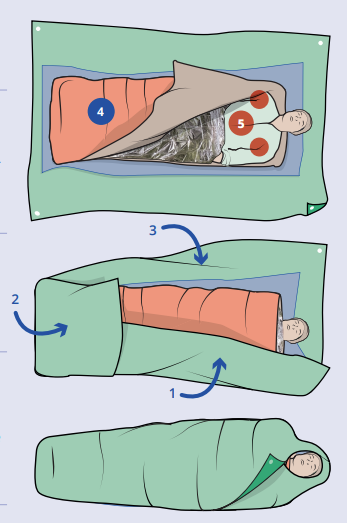Introduction
Accidental hypothermia is a common medical emergency in cold or damp environments, requiring well-established protocols to minimize heat loss. Among recent advances, the vapor barrier stands out as an effective solution for limiting heat loss through evaporation. Recently incorporated into the SIRIUSMEDx "burrito" model whit the publication of the field manual and update of the online encyclopedia, this technique aims to improve first aid practices for hypothermia victims.
The study presented in this article, explores the results of a study on the effectiveness of the vapor barrier, details its integration into the "burrito" model and examines its limitations and application contexts.
What is a vapor barrier?
A vapor barrier is an impermeable layer applied directly to wet clothing or the victim's skin. Its main purpose is to reduce heat loss due to evaporation, one of the main sources of cooling in hypothermia. By retaining water vapor close to the body, it limits heat loss while improving thermal comfort.
Recent study on vapor barrier efficiency
Mydske, S., Brattebø, G., Østerås, Ø., Wiggen, Ø., Assmus, J., & Thomassen, Ø. (2024). Effect of a vapor barrier in combination with active external rewarming for cold-stressed patients in a prehospital setting: a randomized, crossover field study. Scandinavian Journal of Trauma, Resuscitation and Emergency Medicine, 32(35). https://doi.org/10.1186/s13049-024-01204-2
Objective:
Test the effectiveness of a vapor barrier combined with an active heat source on skin warming, humidity and thermal comfort.
Methodology : -
- Participants: 16 volunteers exposed to a simulated cold room, dressed in wet clothes.
- Intervention: Comparison of a "burrito" model with and without a vapor barrier.
- Measurements: skin temperature, core temperature, humidity and thermal comfort.
Main results :
- Skin warming: A significant increase of 0.93°C after 60 minutes in the steam barrier group.
- Reduced humidity: humidity reduced to 41% compared to 81% in the group without barrier.
- Thermal comfort: Participants wrapped with a barrier reported a perceived improvement in comfort.
- Core temperature: No significant difference, probably due to the "afterdrop" phenomenon.
Study conclusion:
The vapor barrier is effective in limiting heat loss through evaporation, accelerating skin warming and improving thermal comfort for victims.
The SIRIUSMEDx "burrito" Method: Vapor Barrier Integration

The “burrito” method is a hypothermia management protocol taught by SIRIUSMEDx. With the recent publication of the field manual and update of the online encyclopedia, the vapor barrier was integrated as an additional element to optimize the effectiveness of the model, especially in conditions where the victim is wet. Here are the updated steps of this method:
- Waterproof and windproof layer: A waterproof tarp or blanket is placed under the victim to block conduction losses and protect from the elements.
- Insulating layer : A floor mat or insulating blankets to limit convection losses.

- Vapor barrier: A survival blanket or other waterproof material is applied directly to wet clothing or skin.
- Thermal retention equipment: A sleeping bag or insulating blanket to retain accumulated heat.
- Heat source: If available, hot water bottles, heating packs or similar equipment are placed on strategic areas (armpits, chest).
Limitations and situations where the steam barrier may not be necessary
Although a vapor barrier is very effective, it's not always essential. Here are cases where its use could be limited or omitted:
- Dry victims and a dry environment:
- If the victim has no wet clothes and is in a dry environment, the vapor barrier has little effect on heat loss.
- Rapid transport to a controlled environment:
- If the victim can be moved quickly to a warm, dry place, the priority will be to remove wet clothing and actively warm the victim.
- Risk of condensation :
- If incorrectly applied, the vapour barrier can trap moisture and compromise the effectiveness of other insulating layers.
- Severe hypothermia :
- In severely hypothermic victims (temperature < 28°C), where peripheral circulation is severely reduced, skin rewarming has a limited impact without internal rewarming.
Practical applications and recommendations
- Protocol standardization : Integrate the vapor barrier into hypothermia management protocols for cold or humid environments.
- First-aid training : Include practical sessions on the correct use of the vapor barrier in all first aid courses, with an emphasis on its rapid and effective application.
- Equipment development : Design compact emergency kits incorporating vapor barriers, insulation and heat sources.
- Contextual awareness : Train rescue teams to assess the situations where the vapor barrier is most relevant, and to combine it with other elements to maximize its effectiveness.
Conclusion
The vapor barrier is an effective tool for limiting heat loss and improving the management of hypothermia victims. Its recent integration into the SIRIUSMEDx “burrito” model reflects scientific advances and ensures better adaptation to field realities. Although its use is not always necessary, it is a key solution in many emergency scenarios in hostile environments. By enhancing training and developing appropriate equipment, emergency responders can maximize their effectiveness and improve victims' chances of survival.

